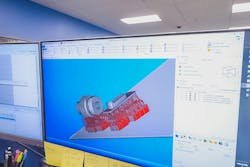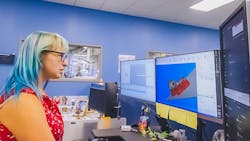One thing that computer-aided design (CAD) brings to additive manufacturing is the means to create objects of incredible complexity that, at first glance, seem to be entirely manufacturable. Design without limits is a term that has been thrown around for a while. Soon, reality sets in when you discover that one area of your amazing part sags, another area refuses to stand upright and geometries that shouldn’t touch have merged.
The moral of the story: “Just because you can design it, doesn’t mean you can do it.” That’s where design for additive manufacturing (DfAM) comes in handy.
Sometimes it’s hard to give up our dreams—er uh, favorite design elements—but more often a comment from a friend can save you a lot of grief later. For 3D printing, that help comes in the form of DfAM. In the old days, the rules of what would make a successful part came from books, charts and plain old memory of what worked historically. That era of manual DfAM worked (sometimes), though memories can often be incomplete.
In the early days of 3D printing, when the process was more of a hobby than industrial in scope, mistakes were expected. As technology improved over time and the stakes grew higher with the emergence of industrial 3D printing, mistakes meant a hit to the bottom line. DfAM had to be codified.
What had started as a set of simple best practices morphed into a body of formalized principles based on the desired outcomes from each 3D printing process. These were informed by the need to reduce print time and its attendant cost; avoiding time-sucking support structures where possible; orienting the part on the print bed to improve efficiency; and choosing materials that provide the characteristics you most need in each part.
READ MORE: How to Use Simulation and Interactive Modeling for Additive Manufacturing
Automated Design for Manufacturing
Needless to say, it is incredibly inefficient to have to look up the DfAM rules for each geometry in your part(s), and with the newer CAD programs—such as Fusion 360, Creo and SOLIDWORKS—there is some degree of onboard design for manufacturing (DfM) validation. There are also standalone solutions such as DFMPro and open-source OpenDFM. These all provide real-time feedback that has proven to be hugely important to designers and engineers.
Many digital manufacturers also offer DFAM advisories to guide customers quoting parts. Protolabs, for example, offers the option to simply approve specific design changes within the quoting process so designs can adhere to a more enhanced rapid prototyping environment.
This Industry 4.0-informed practice is done through the creation of a digital twin, which simulates the part on-screen, allowing for DfAM evaluation and for customers to see the difference the suggested changes would make on their parts. Remaining in the digital realm for DfAM feedback means that parts can be iterated instantly, without the need to wait for repeated cycles of printing, shipping, customer response and reprinting.
READ MORE: Replacement Parts are a 3D Print Away
Industry 4.0’s Effect on DfAM
Industry 4.0 stipulates that more effort be expended prior to printing, using digital twins to simulate actual production. In that manner, communication is maximized, speed is enhanced and material usage decreases. Iteration becomes a numerical exercise, devoid of physical output.
The initial aim for DfAM had been to enhance opportunities for rapid prototyping, and while the existing benefits are substantial, in-quote DfAM remains a work-in-progress. Modern quoting systems can inform you about things like:
- Ensuring wall thicknesses that are strong enough to do the job, but not excessive in material use.
- Helping suggest optimal part orientation to speed printing and maintain strength, also to ensure that the part doesn’t exceed the size limitations of the printer.
- Avoiding small gaps that might merge during printing.
- Limiting overhangs and support structures to avoid excessive material use and reduce manufacturing time.
READ MORE: Hannover Messe 2024 Preview: Automation, Digitalization and Electrification
Leaning on Industry 4.0 for ideas, DfAM would help inform end-users about myriad topics more related to end-use production parts, rather than simply prototyping. The future holds some amazing possibilities for digital manufacturing, and specifically 3D printing. More than likely within the next 10 years we’ll see advances that include:
- Automated in-quote material selection that satisfies the specifications of a given part and allows the designer/engineer to choose from available stocks of plastics and metals for printing.
- Critical-to-quality DfAM, which allows users to define which of the geometries of a part are absolute must-haves, as opposed to ones that are negotiable and can save time/money.
- Warp analysis. Automation that can simulate factors such as printing temperature, cooling settings, material properties and print geometry to ensure that the part won’t sag, warp, or have some other physical deformity.
- Limiting support structures. While often necessary—especially with certain printing processes—these can truly slow down manufacturing. This would feature automation that evaluates physical characteristics in a part and determines which ones require support and which ones don’t, adjusting print orientation if necessary to achieve success.
These would present themselves at quoting time as extensive DfAM advisories that can be accepted or rejected by the customer, speeding manufacturing while educating at the same time. This is particularly helpful if your manufacturer has specific requirements for their service.
Just a few years ago, the thought of these advances seemed like science fiction. In truth, we are entering an information-rich era in which the people who can amass and evaluate available datapoints successfully will lead their industry. It’s a seismic shift, but we’re already seeing elements of it in companies with advanced DfAM systems. The key is to embrace the future and find your niche within it.
Eric Utley is 3D printing applications engineering manager at Protolabs.


